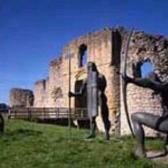Helmsley Castle
Region: Yorkshire and the Humber
Local Authority: Ryedale
Owner Type: English Heritage
Funding Body: English Heritage; Yorkshire Forward; European Regional Development Fund
Year of Intervention: 2003
Summary: Helmsley Castle: state-of-the-art visitor facilities supported by the European Regional Development Fund (Objective 2) boost local economy and the visitor experience.
Description: Built in the late twelfth century, Helmsley is an example of the transition in castle design between the older motte and bailey type and the newer fortification enclosed in concentric rings of stone defences. Over the centuries the fortress was continually strengthened using the latest technology of the day to make it exceptionally strongly defended. And by the time the castle reached its own "middle-age", it remained remarkably untouched by the violence of medieval feuds and cross border raids. However, during the English civil war in 1644 the parliamentary forces of General Thomas Fairfax, fresh from victory at Marston Moor, targetted the royalists at Helmsley Castle. From then on the fortress became more of a des res than military bastion.
Issue: The main issues that needed to be addressed were: A) Placing the Castle more firmly within its wider landscape context B) Improving access for all C) Improving interpretation D) Encouraging sustainable tourism in the area
Strategy: Funding was secured from the European Regional Development Fund. This was through close liaison between English Heritage, Ryedale District Council, Government Office for Yorkshire and the Humber and the North York Moors National Park to develop an appropriate project which met everyone's objectives. A clear case for support was made based on the economic multiplier effects of the proposed investment, it is anticipated that the project will bring £2m extra to the local economy and create 20 new jobs. The scheme cost around 1 million pounds. An access audit of the Castle was completed by English Heritage, and the key recommendations arising from this were fed into the project design to develop site facilities. A new state-of-the-art visitor centre was developed, which provides the opportunity to present historic collections associated with the Castle for the first time. A research project was undertaken to link the castle to its wider context, and to present this to the visitor in a rolling programme of exhibitions. It also considered physical links (footpaths, cycleways etc) between the castle, town, and other heritage attractions in the area, such as Rievaulx Abbey.
Outcome: The result is a stunning new contemporary visitor centre, fascinating exhibitions, greatly improved disabled access, new audio tours and interactive displays that will transform the visitor experience and boost the local economy. English Heritage also stages special events at the castle to provide memorable family days out. These include a medieval feast and festival, demonstrations of arms and armour, falconry, storytelling and many other hands-on sessions. This project illustrates that the historic environment can be embedded within sustainable tourism and economic growth in rural areas.
Keywords: Education and Outreach, Funding, Presentation and Interpretation
© English Heritage


